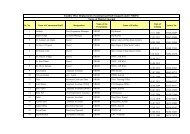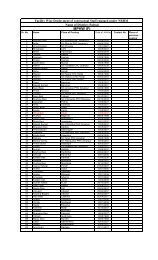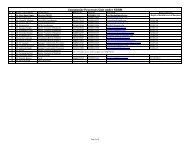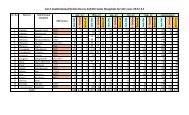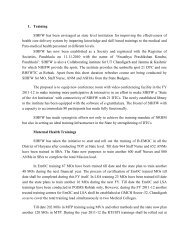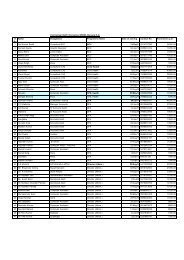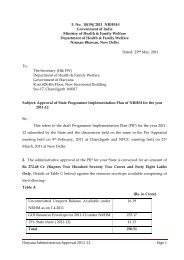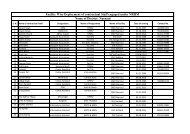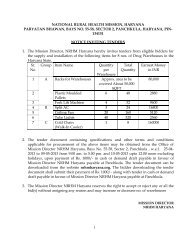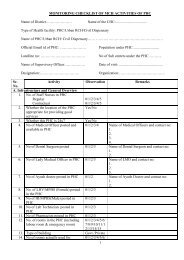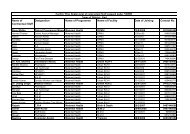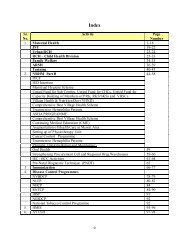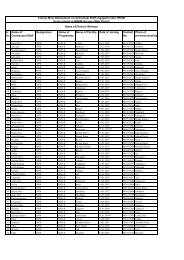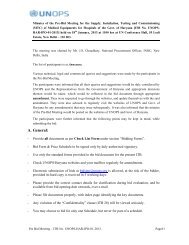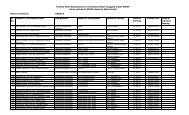Janani Suraksha Yojana (JSY) - Nrhmharyana.org
Janani Suraksha Yojana (JSY) - Nrhmharyana.org
Janani Suraksha Yojana (JSY) - Nrhmharyana.org
Create successful ePaper yourself
Turn your PDF publications into a flip-book with our unique Google optimized e-Paper software.
Ministry of Health and Family Welfare<br />
Page 1 of 13<br />
JANANI SURAKSHA YOJANA<br />
As in October 2006<br />
Government of India<br />
Ministry of Health and Family Welfare<br />
Maternal Health Division<br />
Nirman Bhavan<br />
New Delhi<br />
JANANI SURAKSHA YOJANA (<strong>JSY</strong>)<br />
<strong>Janani</strong> <strong>Suraksha</strong> <strong>Yojana</strong> (<strong>JSY</strong>) is a safe motherhood intervention under the National Rural Health Mission (NRHM) being implemented with the<br />
objective of reducing maternal and neo-natal mortality by promoting institutional delivery among the poor pregnant women. The <strong>Yojana</strong>, launched on 12 th<br />
April 2005, by the Hon’ble Prime Minister, is being implemented in all states and UTs with special focus on low performing states.<br />
2. <strong>JSY</strong> is a 100 % centrally sponsored scheme and it integrates cash assistance with delivery and post-delivery care. The success of the scheme would<br />
be determined by the increase in institutional delivery among the poor families<br />
3. The <strong>Yojana</strong> has identified ASHA, the accredited social health activist as an effective link between the Government and the poor pregnant women in<br />
l0 low performing states, namely the 8 EAG states and Assam and J&K and the remaining NE States. In other eligible states and UTs, wherever, AWW<br />
and TBAs or ASHA like activist has been engaged in this purpose, she can be associated with this <strong>Yojana</strong> for providing the services.<br />
3.1 Role of ASHA or other link health worker associated with <strong>JSY</strong> would be to:<br />
<br />
<br />
<br />
<br />
<br />
<br />
<br />
<br />
<br />
<br />
Identify pregnant woman as a beneficiary of the scheme and report or facilitate registration for ANC,<br />
Assist the pregnant woman to obtain necessary certifications wherever necessary,<br />
Provide and / or help the women in receiving at least three ANC checkups including TT injections, IFA tablets,<br />
Identify a functional Government health centre or an accredited private health institution for referral and delivery,<br />
Counsel for institutional delivery,<br />
Escort the beneficiary women to the pre-determined health center and stay with her till the woman is discharged,<br />
Arrange to immunize the newborn till the age of 14 weeks,<br />
Inform about the birth or death of the child or mother to the ANM/MO,<br />
Post natal visit within 7 days of delivery to track mother’s health after delivery and facilitate in obtaining care, wherever necessary,<br />
Counsel for initiation of breastfeeding to the newborn within one-hour of delivery and its continuance till 3-6 months and promote family planning.<br />
Note: Work of the ASHA or any link worker associated with <strong>Yojana</strong> would be assessed based on the number of pregnant women she has been able to motivate to deliver in a health<br />
institution and the number of women she has escorted to the health institutions.<br />
4. Important Features of <strong>JSY</strong>:<br />
4.1 The scheme focuses on the poor pregnant woman with special dispensation for states having low institutional delivery rates namely the states of<br />
Uttar Pradesh, Uttaranchal, Bihar, Jharkhand, Madhya Pradesh, Chhattisgarh, Assam, Rajasthan, Orissa and Jammu and Kashmir. While these states have<br />
been named as Low Performing States (LPS), the remaining states have been named as High performing States (HPS).<br />
4.2 Tracking Each Pregnancy: Each beneficiary registered under this <strong>Yojana</strong> should have a <strong>JSY</strong> card along with a MCH card. ASHA/AWW/ any<br />
other identified link worker under the overall supervision of the ANM and the MO, PHC should mandatorily prepare a micro-birth plan. Please see<br />
Annexure – I. This will effectively help in monitoring Antenatal Check-up, and the post delivery care.<br />
4.3 Eligibility for Cash Assistance:<br />
LPS States<br />
HPS States<br />
LPS & HPS<br />
All pregnant women delivering in Government health centres<br />
like Sub-centre, PHC/CHC/ FRU / general wards of District<br />
and state Hospitals or accredited private institutions<br />
BPL pregnant women, aged 19 years and above<br />
All SC and ST women delivering in a government health<br />
centre like Sub-centre, PHC/CHC/ FRU / general ward of<br />
District and state Hospitals or accredited private institutions<br />
Note: BPL Certification – This is required in all HPS states. However, where BPL cards have not yet been issued or have not been updated, States/UTs would formulate a simple<br />
criterion for certification of poor and needy status of the expectant mother’s family by empowering the gram pradhan or ward member.<br />
4.4 Scale of Cash Assistance for Institutional Delivery:<br />
Category Rural Area Total Urban Area Total<br />
Mother’s ASHA’s Rs. Mother’s ASHA’s Rs.
Ministry of Health and Family Welfare<br />
Page 2 of 13<br />
Package Package Package Package<br />
LPS 1400 600 2000 1000 200 1200<br />
HPS 700 700 600 600<br />
Note 1: Importantly, such woman in both LPS and HPS states, choosing to deliver in an accredited private health institution will have to produce a proper BPL or a SC/ST<br />
certificate in order to access <strong>JSY</strong> benefits. In addition she should carry a referral slip from the ASHA/ANM/MO and the MCH - <strong>Janani</strong> <strong>Suraksha</strong> <strong>Yojana</strong> (<strong>JSY</strong>) card.<br />
Note 2: ANM / ASHA / MO should make it clear to the beneficiary that Government is not responsible for the cost of her delivery. She has to bear cost, while choosing to go to an<br />
accredited private institution for delivery. She only gets her entitled cash.<br />
4.5 While mother will receive her entitled cash, the scheme does not provide for ASHA package for such pregnant women choosing to deliver in an<br />
accredited private institution.<br />
4.6 Limitations of Cash Assistance for Institutional Delivery:<br />
In LPS States<br />
In HPS States<br />
All births, delivered in a health centre – Government<br />
or Accredited Private health institutions. Refer to<br />
para (b).<br />
Upto 2 live births.<br />
4.7 Disbursement of Cash Assistance: As the cash assistance to the mother is mainly to meet the cost of delivery, it should be disbursed effectively at<br />
the institution itself.<br />
4.7.1 For pregnant women going to a public health institution for delivery, entire cash entitlement should be disbursed to her in one go, at the health<br />
institution. Considering that some women would access accrediting private institution for antenatal care, they would require some financial support to<br />
get atleast 3 ANCs including the TT injections. In such cases, atleast three-fourth (3/4) of the cash assistance under <strong>JSY</strong> should be paid to the<br />
beneficiary in one go, importantly, at the time of delivery.<br />
4.7.2 To Beneficiary:<br />
a. The mother and the ASHA (wherever applicable) should get their entitled money at the heath centre immediately on arrival and registration for<br />
delivery.<br />
b. Generally the ANM/ ASHA should carry out the entire disbursement process. However, till ASHA joins, AWW or any identified link worker,<br />
under the guidance of the ANM may also do the disbursement.<br />
4.7.3 At accredited private institution: Disbursement of cash to the mother should be done through the ANM/ASHA/ Link worker channel and the<br />
money available under <strong>JSY</strong> should be paid to the beneficiary only and not to any other person or relative. Also refer to para (e).<br />
<br />
Should ensure that:<br />
• Such accredited private institution would also be responsible for any postnatal complication arising out of the cases handled by them.<br />
• They should not deny their services to any referred targeted expectant mother.<br />
Note: Every month, accredited private health centers would prepare a statement of <strong>JSY</strong> - delivery / ANC/ obstetric complication cases handled by<br />
them and send it to the Medical officer, along with the referral slips for sample verification by the concerned ANM / ASHA.<br />
4.7.4 In the District / Women’s Hospital / State Hospital etc :<br />
• State / District should allocate sufficient amount of money (based on the load of deliveries in these institutions) for each of these institution.<br />
This money should be kept in a separate account under the supervision of the Rogi Kalyan Samity.<br />
• The residency of the beneficiary would determine entitlement of cash benefit in such institutions, to be verified based on the referral slip<br />
from the ANM, carried by the beneficiary.<br />
Format of Referral Slip: State should prepare a format of the referral slip, which should<br />
mainly indicate, identification details of the beneficiary, <strong>JSY</strong> registration number in the<br />
register of the ANM, reason for referral (including medical complications), name of ASHA,<br />
amount already disbursed, amount due, including referral transport money (if applicable),<br />
amount due to ASHA and to be paid, signature of MO/ANM.<br />
• It is therefore, essential that all targeted expectant mother should carry a referral slip from the ANM/MO where she generally resides. This<br />
will, infact, help all such pregnant woman who go to her mother’s place for delivery.<br />
• Disbursement of money to expectant mother going to her mother’s place for delivery should be done at the place she delivers. The<br />
entitlement of cash should be determined by her referral slip carried by her and her usual place of residence.<br />
• A voucher scheme may be introduced in such a way that along with admission slip for delivery, a voucher amounting to mother’s package<br />
plus the transport assistance money is given to the expectant mother and that she should be able to encash the same at the Hospital’s cash<br />
counter, at the time of discharge.<br />
4.8 Flow of Fund:<br />
i. State/ District authorities would advance Rs. 5000/- and Rs. Rs.10,000/- to each ANM in HPS /LPS States respectively as a recoupable<br />
impressed money from the <strong>JSY</strong> fund.<br />
ii. This money could be kept in the joint account of ANM and Gram Pradhan, as in case of untied fund placed with sub-centers so that the<br />
ANM could ‘roll’ the entire amount by advancing Rs.1500 to Rs. 2,500/- to ASHA / AWW per delivery and later she could recoup it from the<br />
PHC or CHC, where <strong>JSY</strong> fund is parked by the authorities.<br />
Expenditure Monitoring: ASHA / AWW should provide an expenditure statement of money<br />
advanced to her in previous month to the ANM in the monthly meeting held by ANM.<br />
iii. There should be a clear authority for ANM to withdraw cash from this account for advancing it to the ASHA or AWW / any other health<br />
link worker, needed for ready use towards disbursement to the pregnant and also for arranging the referral transport for escorting the pregnant<br />
women to the institution.<br />
Note: Where an elected body of the Panchayati Raj Institution (PRIs) exists, the State<br />
Governments/Health society may keep the money in a joint account of the Gram Pradhan and the ANM<br />
(like that of the untied fund). The process of recoupment of fund should be so simple to be able to<br />
disburse the cash to the pregnant women in time.<br />
4.9 ASHA Package: This package, as of now, is available in all LPS, NE States and in the tribal districts of all states and UTs. In rural areas it
Ministry of Health and Family Welfare<br />
Page 3 of 13<br />
includes the following three components:<br />
• Cash assistance for Referral transport to go to the nearest health centre for delivery. The state will determine the amount of assistance<br />
(should not less than Rs.250/- per delivery) depending on the topography and the infrastructure available in their state. It would, however, be<br />
the duty of the ASHA and the ANM to <strong>org</strong>anize or facilitate in <strong>org</strong>anizing referral the transport, in conjunction with gram pradhan, Gram Sabha<br />
etc.<br />
Note: This assistance is over and above the Mother’s package.<br />
• Cash incentive to ASHA: This should not be less than Rs.200/- per delivery in lieu of her work relating to facilitating institutional delivery.<br />
Generally, ASHA should get this money after her postnatal visit to the beneficiary and that the child has been immunized for BCG.<br />
• Transactional cost (Balance out of Rs.600/-) is to be paid to ASHA in lieu of her stay with the pregnant woman in the health centre for<br />
delivery to meet her cost of boarding and lodging etc.. Therefore, this payment should be made at the hospital/ heath institution itself.<br />
Note 1: In Urban areas, ASHA package consists of only the incentive for ASHA, for providing the<br />
services, as at para 3.1<br />
Note 2: In case ASHA fails to <strong>org</strong>anize transport for the pregnant woman to go to the health institution,<br />
transport assistance money available within the ASHA’s package should be paid to the pregnant woman<br />
at the institution, immediately on arrival and registration for delivery.<br />
Note 3: In case ASHA is yet to join, transport assistance money may be kept with the institution and a<br />
voucher scheme may be introduced for disbursement.<br />
4.10 Payment to ASHA: ASHA should get her-<br />
<br />
<br />
First payment for the transactional cost at the health centre on reaching the institution along with the expectant mother.<br />
The second payment should be paid after she has made postnatal visit and the child has been immunized for BCG.<br />
All payments to ASHA would be done by the ANM only. In this case too, a voucher scheme be introduced in such a manner that for every pregnant<br />
woman she registers under <strong>JSY</strong>, ANM would give two vouchers to ASHA, which she would be able to encash on certification by ANM.<br />
Important: It must be ensured that ASHA gets her second payment within 7 days of the delivery, as that would be essential to keep her sustained in the system.<br />
4.11 Special Dispensation for LPS states:<br />
<br />
<br />
<br />
Age restriction removed<br />
Restricting benefits of <strong>JSY</strong> up to 2 births removed. In other words, the benefits of the scheme are extended to all pregnant women in LPS states<br />
irrespective of birth orders.<br />
No need for any marriage or BPL certification provided woman delivers in Government or accredited private health institution.<br />
Important: The state / UTs would be responsible for instituting an appropriate monitoring mechanism and ensure that a proper accounting procedure is<br />
put in place for all transactions.<br />
4.12 Subsidizing cost of Caesarean Section or management of Obstetric complications: Generally PHCs/ FRUs / CHCs etc. would provide<br />
emergency obstetric services free of cost. Where Government specialists are not available in the Govt’s health institution to manage complications or for<br />
Caesarean Section, assistance up to Rs. 1500/- per delivery could be utilized by the health institution for hiring services of specialists from the private<br />
sector. If a specialist is not available or that the list of empanelled specialist is very few, specialist doctors working in the other Government set-ups<br />
may even be empanelled, provided his/her services are spare and he/she is willing. In such a situation, the cash subsidy can be utilized to pay honorarium<br />
or for meeting transport cost to bring the specialist to the health centre. It may however be remembered that a panel of such doctors from private or<br />
Government institutions need to be prepared beforehand in all such health institutions where such facility would be provided and the pregnant<br />
women are informed of this facility, at time of micro-birth planning.<br />
Important: State Governments would ensure that this assistance is not misutilized and would exercise adequate control and monitor expenditure under this component.<br />
4.13 Assistance for Home Delivery: In LPS and HPS States, BPL pregnant women, aged 19 years and above, preferring to deliver at home is entitled to<br />
cash assistance of Rs. 500/- per delivery. Such cash assistance would be available only upto 2 live births and the disbursement would be done at the time<br />
of delivery or around 7 days before the delivery by ANM/ASHA/ any other link worker. The rationale is that beneficiary would be able to use the<br />
cash assistance for her care during delivery or to meet incidental expenses of delivery. It should be the responsibility of ANM/ASHA, MO PHC to ensure<br />
disbursement. It is very important that the cash is disbursed in time. Importantly, such woman choosing to deliver at home should have a BPL certificate<br />
to access <strong>JSY</strong> benefits.<br />
5. . Compensation Money: If the mother or her husband, of their own will, undergoes sterilization, immediately after the delivery of<br />
the child, compensation money available under the existing Family welfare scheme should also be disbursed to the mother at the<br />
hospital itself.<br />
6. <strong>JSY</strong> Benefits in Accredited Private Health Institution: In order to increase choice of delivery care institutions, , at least two<br />
willing private institutions per block should be accredited to provide delivery services. . State and the district authorities should<br />
draw up a list of criterion / protocols for such accreditation. (Please see a model criterion at Annexure-2)<br />
Such beneficiaries delivering<br />
in these institutions would get the cash benefits admissible under the <strong>JSY</strong>.<br />
7. Equip Sub-centers for Normal delivery: For women living in tribal and hilly districts, it becomes difficult to access PHC/CHCs<br />
for maternal care or delivery. A well-equipped sub-center is a better option for normal delivery. Deliveries conducted in subcenters,<br />
which are accredited by the state / district authorities will be considered as institutional delivery and therefore, women<br />
delivering in these centers would be eligible for all cash assistance under <strong>JSY</strong>.<br />
Important: All States and UTs to undertake a process of accreditation of all such sub-centre located in Govt. buildings and having proper facility of<br />
light, electricity, water, and other medical requirements of basic obstetric services including drugs, equipments and services of trained mid-wife for the<br />
purpose of conducting normal deliveries in these institutions.<br />
8. Provision of Administrative Expenses: Upto 4 % and 1% of the fund released could be utilized towards administrative expenses<br />
like monitoring, IEC and office expenses for implementation of <strong>JSY</strong> by the district and state authorities respectively.<br />
9. Essential Strategy: While the scheme would create demand for institutional delivery, it would be necessary to have adequate number of 24X7 delivery<br />
services centre, doctors, mid-wives, drugs etc. at appropriate places. Mainly, this will entail<br />
• Linking each habitation (village or a ward in an urban area) to a functional health centre- public or accredited private institution where 24X7 delivery service<br />
would be available,<br />
• Associate an ASHA or a health link worker to each of these functional health centre,<br />
• It should be ensured that ASHA keeps track of all expectant mothers and newborn. All expectant mother and newborn should avail ANC and immunization<br />
services, if not in health centres, atleast on the monthly health and nutrition day, to be <strong>org</strong>anised in the Anganwadi or sub-centre:<br />
o<br />
o<br />
o<br />
o<br />
o<br />
o<br />
Each pregnant women is registered and a micro-birth plan is prepared (please see Annexure-1)<br />
Each pregnant woman is tracked for ANC,<br />
For each of the expectant mother, a place of delivery is pre-determined at the time of registration and the expectant mother is informed,<br />
A referral centre is identified and expectant mother is informed,<br />
ASHA and ANM to ensure that adequate fund is available for disbursement to expectant mother,<br />
ASHA takes adequate steps to <strong>org</strong>anize transport for taking the women to the pre-determined health institution for delivery.
Ministry of Health and Family Welfare<br />
Page 4 of 13<br />
o<br />
ASHA assures availability of cash for disbursement at the health centre and she escorts pregnant women to the pre-determined health centre.<br />
10. Possible IEC strategy:<br />
• To associate NGO and Self Help Groups for popularizing the scheme among women’s group and also for monitoring of the implementation.<br />
• To provide wide publicity to the scheme by:<br />
Promoting <strong>JSY</strong> as a component of total package of services under RCH along with programmes like Pulse polio programme, Monthly Village Health Day, Health Melas etc,<br />
<br />
<br />
<br />
Printing and distributing <strong>JSY</strong> guidelines, pamphlets, notices in local languages at SC/PHCs/CHCs/ District Hospitals/ DM’s and Divisional Commissioner’s office and even<br />
in at the accredited Pvt. Nursing Homes, in abundance,<br />
Supporting printing of state’s stationery, specially for State’s Health Secretary, DMs / SDMs/ Block/ PHC/ CHC/ District Hospital, advocating on Institutional Delivery and<br />
cash benefits of <strong>JSY</strong>,<br />
Facilitate <strong>org</strong>anizing workshops and meetings in villages / blocks - by women’s group, local leaders (PRIs), Opinion Maker, at functional health institutions on promoting<br />
maternal health in general, Institutional Delivery and <strong>JSY</strong>,<br />
Undertaking wall painting in all sub-centers, PHCs and CHCs, District & State Hospitals and the accredited private institutions,<br />
Supporting women self help Groups and NGOs for promoting the scheme,<br />
Facilitating woman Panchayat member to take review of <strong>Janani</strong> <strong>Suraksha</strong> <strong>Yojana</strong> (<strong>JSY</strong>)<br />
11. Establish a grievance redressal cell in each district, under the District Project Management Unit, mainly to facilitate<br />
meeting people’s genuine grievances on -<br />
<br />
<br />
<br />
Eligibility for the scheme,<br />
Quantum of cash assistance,<br />
Delays in disbursement of the cash assistance,<br />
An officer, supported by an assistant, if necessary, may be made responsible to supervise the grievance cell. However, proper<br />
information about the grievance cell, giving the officer’s name, postal address and his telephone number should be displayed<br />
prominently at all health centers and institutions. If necessary, fund available under administrative expenses could be utilized for<br />
this purpose.<br />
12. Display of names of <strong>JSY</strong> beneficiaries: The list of <strong>JSY</strong> beneficiaries along with the date of disbursement of cash to her<br />
should mandatorily be displayed on the display board at the sub-center, PHC/CHC/District Hospitals (from where beneficiaries<br />
have got the benefit), being updated regularly on month-to-month basis. Wherever necessary, display boards may be procured.<br />
13. Guidelines For urban areas: The state shall prepare detailed guidelines by stating a simple procedure of implementing the<br />
<strong>Janani</strong> <strong>Suraksha</strong> <strong>Yojana</strong> (<strong>JSY</strong>) in the urban areas through the Municipalities/local bodies ((where an elected body exits) and quickly<br />
obtain approval of the state Government/SHS. The guidelines should bring out clearly, the chain of fund flow as well as disbursement<br />
of the benefits to the ultimate beneficiaries. The quantum of grants to be placed at the disposal of the Municipalities shall be in<br />
proportion to the BPL families in the Municipal area. The district annual plan will also include the plan of the municipalities<br />
in the districts wherever applicable. The Chief medical Officer of such an authority should be the implementing authority. It<br />
must be ensured that basic objectives and the scale of disbursements are not altered. A copy such plan along with necessary<br />
Government’s order should be sent to the GOI.<br />
14. Monitoring:<br />
14.1 Monthly Meeting at Sub-centre Level: For assessing the effectiveness of the implementation of <strong>JSY</strong>, monthly meeting of all ASHAs / related health<br />
link workers working under an ANM should be held by the ANM, possibly on a fixed day (may be on the third Friday) of every month, at the sub-center<br />
or at any of Anganwadi Centres falling under the ANM’s area of jurisdiction. If Friday is a holiday, meeting could be held on following working day.<br />
14.2 Prepare Monthly Work Schedule: In the monthly meeting, the ANM, besides reviewing the current month’s work vis-à-vis envisaged activities,<br />
should prepare a Monthly Work Schedule for each ASHA / village level health worker of following aspects of the coming month:<br />
• Feed back on previous month’s schedule -<br />
(a) Number of pregnant women missing ANCs,<br />
(b) No. of cases, ASHA/link worker did not accompany the pregnant women for Delivery,<br />
(c) Out of the identified beneficiary, number of Home deliveries,<br />
(d) No. of post natal visits missed by ASHA,<br />
(e) Cases referred to Referral Unit (FRU) and review their current health status,<br />
(f) No. of children missing immunization.<br />
• Fixing Next Month’s Work Schedule (NMWS): To include -<br />
(i)<br />
(ii)<br />
(iii)<br />
(iv)<br />
(v)<br />
(vi)<br />
(vii)<br />
Names of the identified pregnant women to be registered and to be taken to the health center/Anganwadi for ANC,<br />
Names of the pregnant women to be taken to the health center for delivery (wherever applicable),<br />
Names of the pregnant women with possible complications to be taken to the health center for check-up and/or delivery,<br />
Names of women to be visited (within 7 days ) after their delivery,<br />
List of infants / newborn children for routine immunization,<br />
To ensure availability of imprest cash,<br />
Check whether referral transport has been <strong>org</strong>anized.<br />
Note 1: While no target needs to be fixed, but for the purpose of monitoring, some monthly goal of institutional delivery for the village may be kept.<br />
Note 2: A format of monthly work schedule to be filled by the ANM /ASHA incorporating the physical and financial aspect may be printed.<br />
15. Reporting: For the purpose of reviewing the progress of implementation and also for allocating fund to the state, under the RCH-flexi Pool, all<br />
States would provide<br />
• Annual District-wise report as per Annexure IV, reaching MoHFW in the month of April of the following financial year<br />
• Quarterly Report as per Annexure V, reaching MoHFW in the month following the end of the Quarter.<br />
However, depending on the requirement of the Ministry, special reports may also be sought.<br />
Most Important:<br />
16. Any deviation from the above process will not be accepted by the Central Government and that such expenditure will not be treated as
Ministry of Health and Family Welfare<br />
Page 5 of 13<br />
legitimate utilization of the fund given under <strong>JSY</strong>. It may be noted that all payments before or after seven days of delivery will be treated as illegitimate<br />
subject to audit objection.
Ministry of Health and Family Welfare<br />
Page 6 of 13<br />
Annexure-I<br />
MICRO-BIRTH PLAN FOR <strong>JSY</strong> BENEFICIARIES<br />
STEP Activity To be undertaken by Proposed Time Line<br />
1 Identification and Registration of ANM/ASHA/AWW or any Atleast 20-24 weeks before<br />
beneficiary<br />
link worker<br />
the expected date of delivery.<br />
2 Filling up of Maternal and Child<br />
card ( In duplicate – one each for mother<br />
and ASHA/Link worker)<br />
ANM/ASHA/AWW or an<br />
equivalent link worker<br />
Immediately on registration<br />
3 4 I-s’:<br />
(This will form part of the <strong>JSY</strong>’S<br />
Registration Card).<br />
Inform dates of 3 ANC & TT<br />
Injection (s)<br />
Identify the health center for all<br />
referral<br />
Identify the Place of Delivery<br />
Inform expected date of delivery<br />
ANM/ASHA/AWW or an<br />
equivalent link worker<br />
Immediately on registration<br />
Provide the 1 st ANC immediately on<br />
Registration.<br />
ASHA to follow up the ANCs at the<br />
Anganwadi Centres/Sub-center (SC)<br />
and ensure that the beneficiary<br />
attends the SC/Anganwadi<br />
centre /PHC for ANC on the<br />
indicated dates<br />
4 Collecting BPL or necessary<br />
proofs /certificates<br />
Wherever necessary from Panchayat /<br />
local bodies / Municipalities<br />
5 Submission of the completed <strong>JSY</strong> MO, PHC<br />
card in the Health center for<br />
verification by the<br />
authorized/Medical officer.<br />
II. Take necessary steps toward<br />
arranging transport or making<br />
available cash to the beneficiary to<br />
come to the Health Centre<br />
III. Ensure availability of fund to<br />
ANM/Health worker/ASHA etc.<br />
Motivation: ANM should call the<br />
beneficiary to the Anganwadi/SC to<br />
participate in the Monthly meeting<br />
and explain enhanced cash and<br />
Transport assistance benefits for<br />
Institutional delivery.<br />
ANM/ASHA/AWW or an<br />
link worker<br />
ANM/ASHA/AWW/link<br />
worker<br />
Within 2-4 weeks from<br />
Registration<br />
Atleast 2-4 weeks before the<br />
expected date of delivery<br />
ANM/ MO, PHC<br />
6. Payment of cash benefit / incentive<br />
to the mother and ASHA<br />
ANM/ MO, PHC<br />
At the institution.<br />
For complicated cases or those requiring cesarean section etc:<br />
Ac –1<br />
Ac –2<br />
Ac –3<br />
Ac –4<br />
Pre-determine a Referral health center<br />
and intimate the pregnant women<br />
Familiarize the woman with the<br />
referral centre, if necessary carry a<br />
letter of referral from MO PHC<br />
Pre-<strong>org</strong>anize the transport facility in<br />
consultation with family<br />
members/community leader<br />
Arrange for the medical experts if<br />
the same is not available in the<br />
referred heath center<br />
By ANM/ASHA/link worker<br />
ANM/ASHA/link worker<br />
ANM/ASHA/Community<br />
MO, PHC
Ministry of Health and Family Welfare<br />
Page 7 of 13<br />
CRITERIA FOR ACCREDITATION OF 24 HOURS COMPREHENSIVE<br />
EMERGENCY OBSTETRIC CARE<br />
Annexure-II<br />
Casualty services<br />
<br />
A pregnant woman in labour or distress on entering the hospital at any time during the day or night is directly taken to the obstetric casualty and immediately examined by a<br />
professional with midwifery skills and decision taken within fifteen minutes.<br />
- If there are signs or bleeding, convulsions or shock, she should be immediately attended by the Obstetrician on duty and necessary treatment to be initiated.<br />
- Send the mother to the labour room, ward or operation theatre, depending on the signs and symptoms.<br />
• No pregnant woman in labour or distress should be turned away from the hospital for any reason at any time of the day or night.<br />
• Casualty should be located close to the labour room and theatre.<br />
• Casualty to receive advance intimation about the arrival of the mother and keep the specialist team ready with blood, if needed.<br />
• Casualty should have the following round the clock:<br />
- An obstetrician<br />
- Life saving drugs and IV fluids<br />
- Facility for examining the patient (including pv)<br />
- Emergency protocols<br />
- Telephone connection in the casualty, labour room and blood bank<br />
- Patient transport system within the institution<br />
Emergency Obstetric Procedures<br />
<br />
<br />
<br />
Procedures<br />
- Vaccum extraction<br />
- Forceps delivery<br />
- LSCS<br />
- Emergency Hysterectomy<br />
- Manual removal of placenta<br />
- Dilation and Curettage<br />
- Laparotomy<br />
- Blood transfusion<br />
Facilities<br />
- Separate theatre for above obstetric procedures.<br />
- The Government shall provide at least 4 obstetricians, 4 paediatricians, 2 general surgeons and 2 anaesthetists to each CEmONC centre.<br />
Emergency Newborn Care<br />
• Every delivery to be attended by a staff nurse trained in newborn resuscitation.<br />
• Paediatricians to be available in the institution round the clock for emergency interventions<br />
• Emergency Protocol should be available<br />
Laboratory Services<br />
<br />
24 hours laboratory services including<br />
- Blood grouping, typing and cross matching<br />
- All routine examinations such as haemoglobin, blood glucose, urine sugar, albumin.<br />
Post Natal Care<br />
All normally delivered mothers should be observed in the labour room for at least two hours after delivery. Before transferring the mothers to the postnatal ward, pulse, BP,<br />
firmness of the uterus and amount of vaginal bleeding should be checked.<br />
In the postnatal ward vital signs and height of the uterus should be monitored once in two hours for the first six hours and once in six hours till 24 hours. Twice a day<br />
monitoring until discharge should follow this.<br />
Those mothers who had instrumental vaginal delivery should be observed in the labour ward for six hours after delivery before transferring the mother to the postnatal ward<br />
pulse, BP, firmness of the uterus, urine output and amount of vaginal bleeding should be checked. Postnatal care in the ward is similar to the care provided for normal vaginal<br />
delivery.<br />
Post Operative Care<br />
<br />
Staff<br />
- For the first two hours after surgery, staff nurse remains at the bedside to monitor patient continuously.<br />
- Hourly checkups of vital signs (temperature, pulse, BP, and urine output), for the next six hours.<br />
- Forth hourly check up of vital signs by staff nurse for next two days and thereafter twice daily till discharge.<br />
- Check up by doctor at least once during the first two hours and every sixth hourly for three days and then twice daily till discharge.<br />
Records and Registers<br />
<br />
<br />
<br />
<br />
Parturition Register<br />
Case Records<br />
Reporting Formats<br />
Referral register<br />
Ambulance Services<br />
<br />
For referral<br />
Ambulance with driver and fuel available 24 hours.<br />
Linkages with other ambulance providers.<br />
Casualty to have telephone attender who will <strong>org</strong>anise the transportation.<br />
Adherence to standard emergency treatment protocol<br />
<br />
<br />
Standard emergency treatment protocol should in the casualty, in labour ward and in theatre.<br />
The obstetrician and staff nurse posted in the labour ward and theatre should be thorough with emergency protocol.<br />
Quality of provider- Patient interaction<br />
Patient treated with respect and dignity.<br />
Privacy and confidentiality assured.<br />
Informal payment from patients strictly banned.<br />
Informed consent obtained from the family for major procedure.<br />
Procedures clearly explained to family members.<br />
A female attendant to be permitted in labour room while ensuring asepsis.
Ministry of Health and Family Welfare<br />
Page 8 of 13<br />
*****
Ministry of Health and Family Welfare<br />
Page 9 of 13<br />
Annexure III<br />
JANANI SURAKSHA YOJANA (<strong>JSY</strong>)<br />
FREQUENTLY ASKED QUESTIONS AND ANSWER<br />
Q.1 Has the National Maternity Benefit Scheme (NMBS) been replaced by the <strong>Janani</strong> <strong>Suraksha</strong> <strong>Yojana</strong> (<strong>JSY</strong>) from FY<br />
2005-06?<br />
Ans. Yes. A new 100% centrally sponsored scheme - <strong>Janani</strong> <strong>Suraksha</strong> <strong>Yojana</strong> (<strong>JSY</strong>) has been launched w.e.f 12.04.05. However, the<br />
cash benefits of the National Maternity Benefit Scheme (NMBS) have been incorporated in the <strong>Yojana</strong>.<br />
Q.2 Why <strong>Janani</strong> <strong>Suraksha</strong> <strong>Yojana</strong>?<br />
Ans. The NMBS was not addressing all the concerns of safe motherhood in a focused manner. Need is felt for a comprehensive<br />
package for obstetric care services to save the lives of the mother and the newborn. The main objectives of <strong>JSY</strong> are to reduce<br />
maternal and neo-natal mortality by promoting institutional delivery for making available medical care during pregnancy, delivery<br />
and post delivery period.<br />
Q.3 Is there any change with regards to eligibility criterion for availing benefits of <strong>Janani</strong> <strong>Suraksha</strong> <strong>Yojana</strong>?<br />
Ans. The scheme has expanded the eligibility criterion. As in October 2006, eligibility for cash assistance for institutional delivery is<br />
as follows:<br />
LPS States<br />
HPS States<br />
LPS & HPS<br />
All pregnant women delivering in Government<br />
health centers like Sub-centre, PHC/CHC/ FRU /<br />
general wards of District and state Hospitals or<br />
accredited private institutions<br />
BPL pregnant women, aged 19 years and above<br />
All SC and ST women delivering in a government<br />
health centre like Sub-centre, PHC/CHC/ FRU /<br />
general ward of District and state Hospitals or<br />
accredited private institutions<br />
Q.4 What is basis of LPS and HPS states?<br />
Ans. States with lower levels of institutional delivery rates have been classified as LPS states. These are - the states of Uttar<br />
Pradesh, Uttaranchal, Bihar, Jharkhand, Madhya Pradesh, Chhattisgarh, Assam and Jammu and Kashmir. The remaining states<br />
are named as HPS states.<br />
Q.5 Why there are the special dispensations for pregnant women from LPS states?<br />
(i)<br />
(ii)<br />
(iii)<br />
Age certificate is not an instrument that is available easily. Many LPS states have yet to get the process of birth<br />
registration <strong>org</strong>anised in rural areas. In view of this, for all BPL pregnant women belonging to LPS states, any kind<br />
of age certification would not be insisted upon for availing the benefits of <strong>JSY</strong>.<br />
Removal of restrictions on the number of child births: Restricting the benefits upto 2 births would in fact encourage<br />
women of higher fertility in the LPS states to deliver at home in an unsafe condition. Such women are exposed to higher<br />
risks of mortality and morbidity too because of neglect on their part to access health care and facilities. Therefore, the<br />
restriction on the number of childbirths for accessing benefits of <strong>JSY</strong> has been removed. In other words, the benefits of<br />
the scheme are extended to all BPL pregnant women in LPS states irrespective of birth orders.<br />
Institutional delivery being the primary strategy for promoting safe motherhood, it is necessary that all women are<br />
encouraged to avail institutional care. With a view to encourage women from poor families to access public health<br />
institution for delivery, in LPS states, the benefits of <strong>JSY</strong> would be extended to all women (BPL and APL) availing<br />
institutional delivery care in Govt. health centres like SC, PHC, CHC, FRUs and general wards of the District<br />
and State Hospitals.<br />
Q.6 Is it mandatory to implement <strong>JSY</strong>?<br />
Ans. Yes.<br />
Q.7 Is there any cash benefit for pregnant women from BPL families preferring to deliver at home?<br />
Ans. In LPS and HPS States, BPL pregnant women, aged 19 years and above preferring to deliver at home is entitled to cash<br />
assistance of Rs. 500/- per delivery. Such cash assistance would be available only upto 2 live births and the disbursement would be<br />
done at the time of delivery. The rationale is that beneficiary would be able to use the cash assistance for her care during delivery<br />
or to meet incidental expenses of delivery.<br />
Q.8 If the focus of the scheme is to promote institutional delivery, why should there be a provision for home delivery?<br />
Ans. It is true that we have to discourage home delivery. However, in view of the Hon’ble Supreme Court’s direction, it is mandatory<br />
to provide for home delivery. In case of home delivery, cash benefits of <strong>JSY</strong> are as provided under NMBS. It would be the<br />
responsibility of the ANM, ASHA to counsel the pregnant woman to deliver in a health institution.<br />
Q.9 If the Government’s policy is to control population, why would Government be relaxing two child restrictions under the <strong>Yojana</strong>?<br />
Ans. It is true that couples in the reproductive age group, should have all the options to decide their family size and that the<br />
Government should endeavor to adhere to its stated population policy. <strong>JSY</strong> is a scheme for saving the lives of mothers from the causes<br />
related to delivery, which is also a stated policy of the Government. Women who are in the higher orders of birth, are more at risk of<br />
mortality, as they tend to neglect their delivery care and it is by bringing them to institution, and not by keeping them out of the<br />
domain of institutional delivery care that these high fertility women could be counseled for family planning.<br />
Q.10 When would the cash benefit under <strong>JSY</strong> be disbursed?<br />
Ans. The cash benefit should be disbursed to the beneficiary preferably at the institution. If ASHA is unable to <strong>org</strong>anize<br />
transport (wherever applicable) disbursement of transport assistance should be done in the health centre as soon pregnant<br />
women arrive and registers for delivery. It should be the responsibility of ANM, MO, PHC/ASHA to take all proactive actions to<br />
ensure timely disbursement.<br />
Q.11 What is the rationale for disbursing the cash at the time of delivery?<br />
Ans. It is desired that the cash benefit available under this scheme is used by the beneficiary for pregnancy related care especially at<br />
the time of delivery and also for post delivery care. If cash is given earlier, it is possible that it may be expended for other purposes.<br />
Q.12 If after having received the cash benefit, the child dies, would the benefit under <strong>JSY</strong> be extended for the next birth?
Ministry of Health and Family Welfare<br />
Page 10 of 13<br />
Ans. Yes. Proper record should be maintained.<br />
Q.13 If a still child is born in a health institution, can the benefit of <strong>JSY</strong> be disbursed to the mother?<br />
Ans. Yes. Proper record should be maintained.<br />
Q.14 What is the scale of transport assistance out of ASHA package?<br />
Ans. Generally, an amount of Rs. 250/- may be earmarked for this. It is, however, upto the State Government to determine the scale<br />
of transport assistance. It may be ensured that the incentive to ASHA which is part of ASHA package should not be less then 200/-<br />
per delivery facilitated by her, in addition to the transactional cost of around Rs.150/- per delivery for escorting and staying with the<br />
mother in the health centre. It may be mentioned that ASHA would get cash benefit only if she accompanies the pregnant woman to<br />
the health centre.<br />
Q.15 Where would the transport assistance money be kept ?<br />
Ans. Keeping in view, the need to make available the cash required to transport women in the critical condition of delivery to a<br />
health centre, transport assistance amount should be kept with the ASHA with clear knowledge of the beneficiary. The mode of<br />
transport should be pre-decided by the ANM/medical officers/family member. A proper protocol for arranging the transport should be<br />
put in place with assistance of the community, ASHA and the ANM.<br />
Q.16 Can the parameters of the <strong>JSY</strong> be modified by the states/UTs?<br />
Ans. No. However, if any state or UT has any cogent reason for modifying, it is welcome, in consultation with the GOI. But kindly<br />
note that unilateral change by any state or UT is not advisable as it may lead to audit objections.<br />
Q.17 A poor woman needs treatment for C-Section or other obstetric complications. Is there any provision for such situations under<br />
<strong>JSY</strong>?<br />
Ans. Yes. Generally FRUs / CHCs etc. would provide emergency obst. services free of cost. Where Government specialists are not<br />
available in the Govt’s health institution, assistance up to Rs. 1500/- per case could be utilized by the health institution for hiring<br />
services of experts to carry out the surgery in a Government medical facility. Remember, this assistance is to the Govt. health<br />
institution and not to the beneficiary.<br />
Q.18 Generally, in remote areas, even a private medical expert is not available. What to do then?<br />
Ans. In such a situation, expert doctors working in the other Government health institutions may even be empanelled provided<br />
his/her services are spare. The cash assistance for C-section or any other obstetric complications, limited to Rs.1500 per case, can be<br />
utilized to pay honorarium or for meeting transport cost to bring the expert to health centre. It may however be remembered that a<br />
panel of such doctors need to be prepared beforehand by all such health institutions where such facility would be provided<br />
and the pregnant women are informed of this facility, at time of micro-birth planning.<br />
LINKAGE WITH ASHA<br />
Q.19 What is the role of ASHA under <strong>JSY</strong>?<br />
Ans. ASHA is to act as a facilitator and is an important component of the <strong>JSY</strong> strategy. Her main roles would be as follows:<br />
Identify pregnant woman as a beneficiary of the scheme and report or facilitate registration for ANC,<br />
Assist the pregnant woman to obtain necessary certifications wherever necessary,<br />
Provide and / or help the women in receiving at least three ANC including TT injections, IFA tablets,<br />
Identify a functional Government health centre or an accredited private health institution for referral and delivery,<br />
Counsel for institutional delivery,<br />
Escort the beneficiary women to the pre-determined health canter and stay with her till the woman is discharged,<br />
Arrange to immunize the newborn till the age of 10 weeks,<br />
Inform ANM/MO about the birth or death of the child or mother,<br />
Post natal visit within 7 days of delivery and track mother’s health,<br />
Counsel for initiation of breastfeeding to the newborn within one-hour of delivery and its continuance till 3-6 months and promote<br />
family planning.<br />
The compensation package for ASHA is available to her if she escorts/stays with the pregnant women in the health centres.<br />
Q.20 What is a micro-birth plan?<br />
Ans. The scheme is not of distributing cash benefit, but of providing quality maternity services to the pregnant women too. Microbirth<br />
plan is a tool for efficient coordination of all the activities. It mainly entails –<br />
• Essential activities,<br />
• Who would perform the activities, and<br />
• The desired timeline.<br />
Q. 21 Is it mandatory?<br />
Ans. Yes. It is mandatory to draw a Micro-birth plan for each <strong>JSY</strong> beneficiary besides filling up a Maternal and Child Health Card<br />
(MCH Card).<br />
Q.22 Who would draw the micro-birth plan?<br />
Ans. The micro-birth plan would be drawn by the ANM. ASHA or any other link work would assist and it is essential that they know<br />
the component of the birth plan.<br />
Q. 23 What are the essential components of a micro-birth plan?<br />
Ans. Inform the mother and the family about 4 Is, namely -<br />
• Inform dates of 3 ANC & TT Injection (s) and ensure these are provided,<br />
• Identify the health centre for all referral,<br />
• Identify the Place of Delivery,<br />
• Inform expected date of delivery.<br />
In addition,<br />
<br />
<br />
<br />
<br />
Collecting BPL or necessary proofs /certificates<br />
Timely submission of the completed <strong>JSY</strong> card in the Health centre for verification by the authorized/Medical officer,<br />
Arranging transport for the beneficiary to go to the Health Centre for delivery or complications, well in advance,<br />
Ensuring availability of fund with the ANM/link Health worker/ASHA etc.<br />
Q.24 How would ASHA’s work be adjudged under this scheme?<br />
Ans. Work of the ASHA should be assessed based on the number of pregnant women she has been able to motivate to deliver in a<br />
health institution.
Ministry of Health and Family Welfare<br />
Page 11 of 13<br />
Q.25 Where ASHA has not been recruited; can the ASHA package be disbursed to Anganwadi Worker or to any link worker/Trained<br />
Birth Attendant (TBA)?<br />
Ans. If the Anganwadi worker or the TBA performs all the activities of the ASHA, the ASHA package can be disbursed to them, only<br />
till the time ASHA is available in the village.<br />
Q.26 When a beneficiary does not utilize the services of ASHA even if she is in place, can ASHA package be disbursed?<br />
Ans. No.<br />
Q.27 Will ASHA receive any compensation package if she does not escort the pregnant women to the health centre during delivery?<br />
Ans. If ASHA does not do the antenatal protocol nor she escorts the pregnant women, she will not receive the compensation package.<br />
However, if ASHA has done the ANC protocol (Please ensure from AWW/ANM through a due process set out by the medical<br />
officer, PHC) and arranges an escort after due recording of the reasons for not being able to escort the pregnant women (in a register<br />
maintained by ANM for micro-planning of the delivery of the registered beneficiaries), the package available to ASHA may be<br />
disbursed to her. The officials concerned should exercise due caution and carry out proper checks before disbursement of such cash<br />
benefits.<br />
In such a situation when ASHA or any other health worker –AWW/ANM does not escort the pregnant women to a health centre,<br />
the eligible pregnant women would get additional benefit of the admissible cash benefit earmarked for transport<br />
assistance out of the ASHA’s package.<br />
Q.28 Is the reporting of the implementation status giving details of fund utilized and number of beneficiaries benefited under the <strong>JSY</strong><br />
to the Ministry of Health & Family Welfare, mandatory?<br />
Ans. Six-monthly district wise report need to be sent mandatorily to the central government. This will form the basis of release of<br />
further grants.<br />
Q.29 Is there a role for the Gram Panchayat under the <strong>JSY</strong>?<br />
Ans. Where Panchayati Raj Institutions (PRIs) exist and an elected body is in place, the State Governments/District society may<br />
keep the money in the joint accounts of the ANM and the Gram Pradhan. The Panchayat and the local bodies need to be effectively<br />
involved in BPL certification process in a manner that genuine poor pregnant women are able to benefit from the scheme.<br />
Q.30 Is it mandatory to keep an imprest with ANM ?<br />
Ans. Yes. A recoupable imprest of Rs.5000/- should be kept with ANM. The purpose is to make quick disbursement to the<br />
beneficiary. Out of this, the ANM should keep atleast Rs. 1500/- (recoupable) with the ASHA/Anganwadi Worker so that when the<br />
pregnant women need to be taken to the health institution for delivery, ASHA is able to <strong>org</strong>anize transport quickly. This would<br />
quicken the process of disbursement that is key to the success of <strong>JSY</strong>.<br />
FINANCIAL MATTERS:<br />
Q.31 Is there a separate budget/allocation for <strong>JSY</strong>?<br />
Ans. Unlike under NMBS, grants for <strong>JSY</strong> will be released to the State Health Society (SHS) as part of RCH flexi pool, based on the<br />
recommendation of the NBCC and the State’s PIP. It would be upon the SHS to allocate and disburse the <strong>JSY</strong> fund to the District<br />
Health Society (DHS).<br />
Q.32 Is there any component under the <strong>JSY</strong> grant to meet certain essential expenditures, as a part of the administrative expenses? If<br />
yes, what are the activities permissible under the administrative expenses?<br />
Ans. Yes, Upto 4 % and 1% of the fund released could be utilized towards administrative expenses like monitoring, IEC and office<br />
expenses for implementation of <strong>JSY</strong> by the district and state authorities respectively.<br />
BPL CERTIFICATION:<br />
Q.33 If poor pregnant women do not have BPL Card but otherwise considered very poor and needy by the community, how to certify<br />
and disburse cash benefit under <strong>JSY</strong>?<br />
Ans. The Panchayat and the local bodies need to be effectively involved in the certification of poor and needy expectant mother, in a<br />
manner that genuine poor pregnant women are able to benefit from the scheme. However, if the BPL certification is not available<br />
through a legally constituted process, the beneficiary could still access the benefit on certification by Gram Panchayat/pradhan<br />
provided the delivery takes place in a Government institution. The benefit available under <strong>JSY</strong> will be admissible in a private<br />
hospital only against a regular BPL card whose number etc. has to be quoted in the birth certificate to be issued by the<br />
private institution.<br />
Q. 34 Will there be any requirement of BPL card in LPS states?<br />
Ans. No, provided women access government or accredited health institution for delivery. However, for getting cash component for<br />
home delivery, BPL card would be essential.<br />
Q.35 What about SC and SC women?<br />
Ans. Such women would also not require a BPL certification if they access government or accredited health institution for delivery.<br />
Q36 Can cash benefit of the mother be handed over to the institution, in lieu of the services provided?<br />
Ans. No. Cash benefit to mother has to be given to the mother. It is upto the mother to decide, asto how it is to be utilized. Any<br />
deviation in this regard would be construed as violation and may lead to audit objections.<br />
Q37. When would the ASHA package be disbursed?<br />
Ans. ASHA package is to disbursed in two installment. Transactional cost to be paid to ASHA in lieu of her stay with the<br />
pregnant woman in the health centre for delivery should be paid at the hospital/ heath institution itself. And, cash incentive to ASHA,<br />
being not less than Rs.200/- per delivery in lieu of facilitating institutional delivery should be paid after her post natal visit to the<br />
newly delivered mother and the newborn has been immunized for BCG.<br />
******
Ministry of Health and Family Welfare<br />
Page 12 of 13<br />
Annexure – IV<br />
Part - A<br />
JANANI SURAKSHA YOJANA<br />
DISTRICTWISE ANNUAL STATEMENT OF PHYSICAL PROGRESS FOR THE YEAR ___________________<br />
(To be sent to the Maternal Health Division, Ministry of Health and Family Welfare, GOI by April of following year)<br />
Name of the State ……………………… Name of the Nodal Officer……………… Telephone/Fax No……………………<br />
PHYSICAL PERFORMANCE<br />
S. No Name<br />
NO. OF <strong>JSY</strong> REGISTERED DURING THE QUARTER<br />
Total No. of<br />
of the<br />
Rural Urban Total<br />
Beneficiaries upto<br />
Districts SC ST GEN Total SC ST GEN Total SC ST GEN Total the Quarter<br />
1 2 3 4 5 6 7 8 9 10 11 12 13 14<br />
S.<br />
No.<br />
Name of<br />
the<br />
Districts<br />
OUT OF 14, NUMBER OF WOMEN OPTING FOR INSTITUTIONAL DELIVERIES<br />
Rural Urban Total<br />
SC ST GEN Total SC ST GEN Total SC ST GEN Total<br />
Total No. of<br />
Beneficiaries<br />
upto the<br />
Quarter<br />
Out of 13, No.<br />
of beneficiaries<br />
assisted by an<br />
accredited<br />
worker<br />
(ASHA) #<br />
1 15 16 17 18 19 20 21 22 23 24 25 26 27 28<br />
# Wherever applicable<br />
Date:<br />
Name and Signature of the nodal officer with rubber stamp<br />
Annexure –IV<br />
Part - B<br />
JANANI SURAKSHA YOJANA<br />
DISTRICTWISE ANNUAL STATEMENT OF ACTUAL EXPENDITURE FOR THE YEAR ___________________<br />
(To be sent to the Maternal Health Division, Ministry of Health and Family Welfare, GOI by April of following year)<br />
Name of the State ……………………… Name of the Nodal Officer……………… Telephone/Fax No……………………<br />
Amount Allocated under During the year: (In Rs.lakhs)________________<br />
Amount Released so far During the Year (In Rs.lakhs) ________________<br />
S. No. Name of<br />
the<br />
Districts<br />
# Wherever applicable<br />
Opening<br />
Balance as<br />
on 1 st April<br />
(in ‘000)<br />
Total<br />
Amount<br />
Released by<br />
the State<br />
during the<br />
year<br />
(Rs. in '000)<br />
Total<br />
amount<br />
available<br />
with the<br />
district<br />
(Rs. in '000)<br />
(3 + 4)<br />
Total Expenditure under <strong>Janani</strong> <strong>Suraksha</strong> <strong>Yojana</strong> during the<br />
Quarter (In Rs. ‘000)<br />
To<br />
mother’s<br />
Accredited<br />
worker<br />
ASHA #<br />
Amount<br />
spent on<br />
hiring of<br />
expert for<br />
C - Section<br />
Administrative<br />
Expenditure. if<br />
any<br />
Total<br />
(6+7+8+9)<br />
1 2 3 4 5 6 7 8 9 10 11<br />
:<br />
:<br />
TOTAL<br />
Total<br />
Exp. Upto<br />
the<br />
Quarter<br />
Date:<br />
Name and Signature of the nodal officer with rubber stam<br />
Annexure – V<br />
Part - A<br />
JANANI SURAKSHA YOJANA<br />
QUARTERLY STATEMENT OF PHYSICAL PROGRESS FOR THE QUARTER ENDING _______ FOR THE YEAR____________<br />
(To be sent to the Maternal Health Division, Ministry of Health and Family Welfare, GOI in the following month)<br />
Name of the State ……………………… Name of the Nodal Officer……………… Telephone/Fax No……………………<br />
NUMBER OF <strong>JSY</strong> REGISTERED DURING THE QUARTER<br />
Rural Urban Total<br />
SC ST GEN Total SC ST GEN Total SC ST GEN Total<br />
1 2 3 4 5 6 7 8 9<br />
(1+5)<br />
10<br />
(2+6)<br />
12<br />
(3+7)<br />
13<br />
(4+8)<br />
Total Number of <strong>JSY</strong><br />
Beneficiaries upto the<br />
Quarter<br />
14<br />
OUT OF 13, NUMBER OF WOMEN OPTING INSTITUTIONAL DELIVERIES Total No. of Out of 13, Number of<br />
Institutional beneficiaries assisted<br />
Rural Urban Total<br />
deliveries under by an accredited<br />
SC ST GEN Total SC ST GEN Total SC ST GEN Total<br />
<strong>JSY</strong> upto the worker (ASHA) #<br />
Quarter<br />
14 15 16 17 18 19 20 21 22 23 24 25<br />
26 27<br />
(14+18) (15+19) (16+20) (17+21)<br />
Date:<br />
# Wherever applicable<br />
Name and Signature of the nodal officer with rubber stamp
Ministry of Health and Family Welfare<br />
Page 13 of 13<br />
Annexure – V<br />
Part - B<br />
JANANI SURAKSHA YOJANA<br />
QUARTERLY STATEMENT OF ACTUAL EXPENDITURE FOR THE QUARTER ENDING ________________ FOR THE YEAR_________<br />
(To be sent to the Maternal Health Division, Ministry of Health and Family Welfare, GOI in the following month)<br />
Name of the State …………………… Name of the Nodal Officer……………… Telephone/Fax No……………………<br />
Opening<br />
Balance as<br />
on 1 st<br />
April of<br />
FY<br />
(In Rs.<br />
lakhs)<br />
Amount<br />
Allocated<br />
current year<br />
(In Rs.<br />
lakhs)<br />
Amount<br />
Released<br />
by GOI so<br />
far during<br />
the year<br />
Total<br />
amount<br />
available<br />
with the<br />
State<br />
(In Rs.<br />
lakhs) (2+3)<br />
Total Expenditure under <strong>Janani</strong> <strong>Suraksha</strong> <strong>Yojana</strong> during the Quarter (In<br />
Rs. lakhs)<br />
To<br />
mothers<br />
To<br />
Accredited<br />
worker<br />
ASHA #<br />
Amount spent<br />
on hiring of<br />
specialists<br />
Administrative<br />
Expenditure<br />
made<br />
if any<br />
Total Exp.<br />
during the<br />
quarter<br />
(5+6+7+8)<br />
1 2 3 4 5 6 7 8 9 10<br />
Total Exp.<br />
Upto the<br />
Quarter<br />
(In lakhs)<br />
Date:<br />
Name and Signature of the nodal officer with rubber stamp<br />
# Wherever applicable



